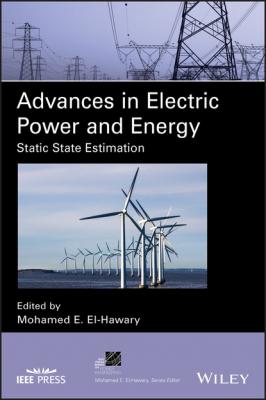Advances in Electric Power and Energy. Группа авторов
Читать онлайн.| Название | Advances in Electric Power and Energy |
|---|---|
| Автор произведения | Группа авторов |
| Жанр | Физика |
| Серия | |
| Издательство | Физика |
| Год выпуска | 0 |
| isbn | 9781119480440 |
(2.29c)
The actual expression of the scalar function J(x) depends on the estimator employed. It can generally be expressed as a function of vector y(x) defined as
2.5.1 Weighted Least of Squares
WLS technique is a non‐robust method that has been well studied in the technical literature [1, 4–7, 16, 17]. This estimator is non‐robust since a single bad measurement can significantly distort the estimation results. The objective function of the WLS estimator is computed as the sum of all squared weighted measurement errors.
2.5.1.1 WLS General Formulation
WLS general formulation is
(2.31a)
subject to
(2.31b)
(2.31c)
where m is the number of measurements.
Figure 2.2 depicts the objective function for the WLS estimator in the case of one single error. The violet and green curves represent a high and low weighting factor ωi, respectively. Note that the weighted measurement error yi(x) = wi ⋅ (hi(x) − zi) appears as yi(x)2 in the objective function J(x).
Figure 2.2 Objective function for the WLS estimator as a function of the error (one measurement).
WLS estimation is typically obtained by solving the first‐order optimality conditions of problem (2.31) via the Newton–Raphson method [18]. Note that nonlinear problem (2.31) is already a mathematical programming problem that is ready to be solved by an appropriate solver, e.g. MINOS [11], within an optimization environment such as AMPL [13] or GAMS [12].
2.5.2 Weighted Least Absolute Value
Since a single bad measurement can severely distort WLS estimation results, other estimators have been proposed with the purpose of improving the robustness of the estimation. Least absolute value (LAV) belongs to the category of robust estimators, i.e. procedures that are less sensitive to bad measurements than WLS technique. This estimator has also been exhaustively analyzed in technical literature [19–22].
The objective function of the LAV estimator is computed as the sum of the absolute values of all weighted measurement errors.
2.5.2.1 LAV General Formulation
The LAV general formulation is
subject to
(2.32b)
(2.32c)
Figure 2.3 depicts the objective function for LAV estimator in the case of one single error. The violet and green curves correspond to a high and low weighting factor ωi, respectively. Note that the weighted measurement error yi(x) = wi ⋅ (hi(x) − zi) appears as ∣yi(x)∣ in the objective function J(x ).
Figure 2.3 Objective function for the LAV estimator as a function of the error (one measurement).
For the sake of generality, problem (2.32) is formulated by considering weighted measurement errors (see (2.30)). Note that some references label this estimator as WLAV (weighted least absolute value).
The objective function (2.32a) comprises the absolute value of vector y(x). This function is nonlinear but can be linearized straightforwardly, resulting in the mathematical programming formulation in Section 2.5.2.2.
2.5.2.2 LAV Mathematical Programming Formulation
LAV mathematical programming formulation is
(2.33a)
subject to
(2.33c)
(2.33d)
In (2.33), note that the required linearization involves the addition of (i) a continuous variable vector s and (ii) two sets of constraints (2.33b).
2.5.3 Quadratic‐Constant Criterion
As previously mentioned, one significant drawback of WLS estimator is the lack of robustness to bad data. Other non‐quadratic estimators have been thereby developed to overcome this disadvantage, such as the aforementioned LAV method.
Quadratic‐constant and quadratic‐linear algorithms (QC and QL) combine the benefits of maximum likelihood least squares estimation and the bad data rejection properties of the LAV estimator.
